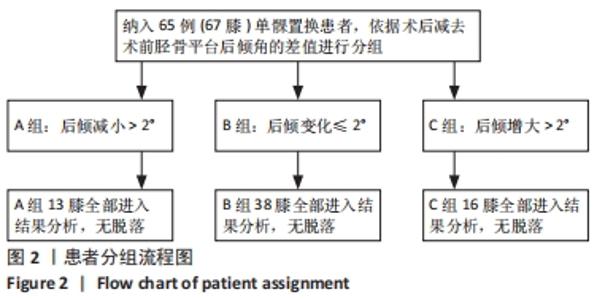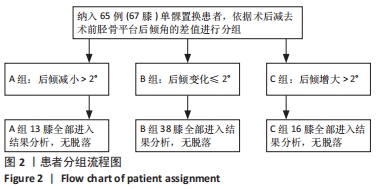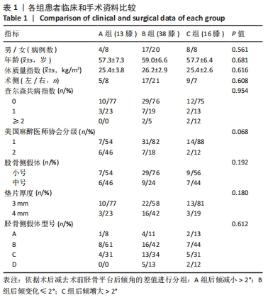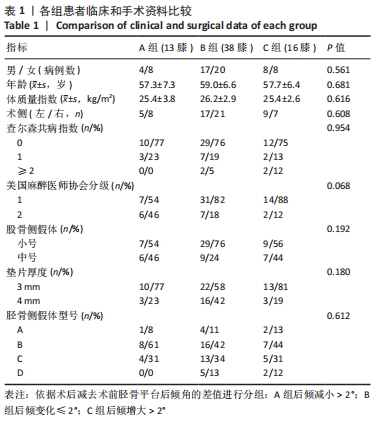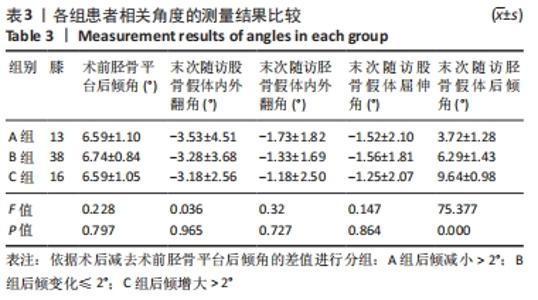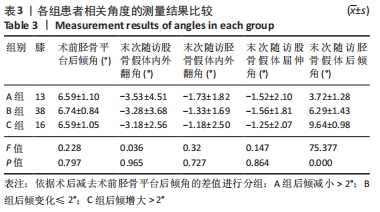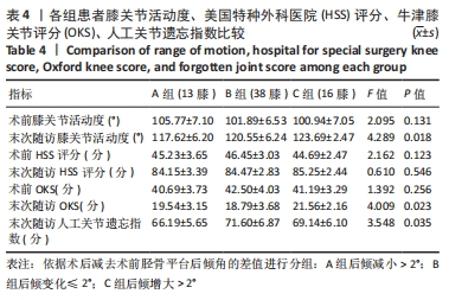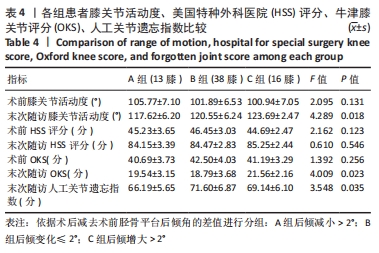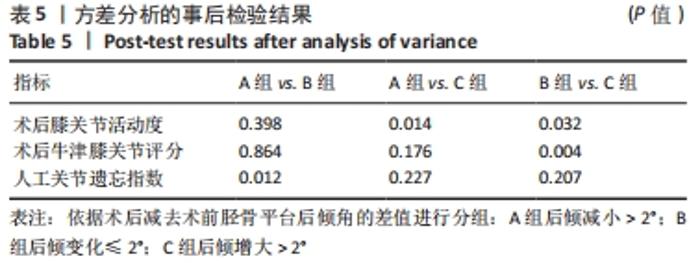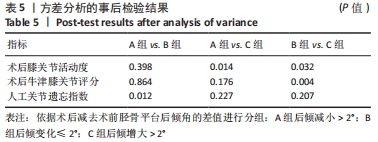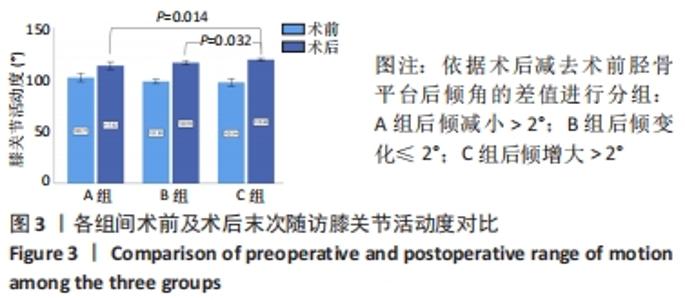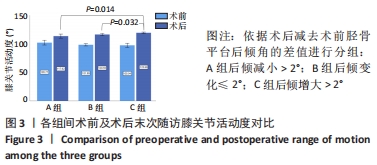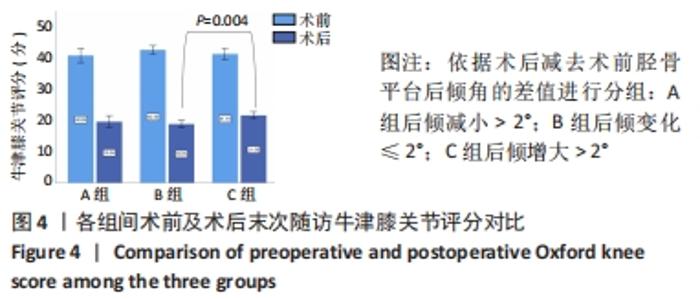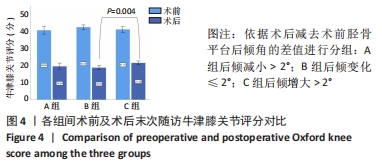Chinese Journal of Tissue Engineering Research ›› 2023, Vol. 27 ›› Issue (18): 2854-2860.doi: 10.12307/2023.283
Previous Articles Next Articles
Significance of changes in posterior tibial slope plateau after unicompartmental knee arthroplasty
Hu Zhenghao, Chen Wang, Feng Shuo, Zhang Leshu, Chen Xiangyang
- Department of Joint Surgery, Affiliated Hospital of Xuzhou Medical University, Xuzhou 221000, Jiangsu Province, China
-
Received:2022-02-28Accepted:2022-05-21Online:2023-06-28Published:2022-09-17 -
Contact:Chen Xiangyang, MD, Chief physician, Associate professor, Department of Joint Surgery, Affiliated Hospital of Xuzhou Medical University, Xuzhou 221000, Jiangsu Province, China -
About author:Hu Zhenghao, Master candidate, Department of Joint Surgery, Affiliated Hospital of Xuzhou Medical University, Xuzhou 221000, Jiangsu Province, China
CLC Number:
Cite this article
Hu Zhenghao, Chen Wang, Feng Shuo, Zhang Leshu, Chen Xiangyang. Significance of changes in posterior tibial slope plateau after unicompartmental knee arthroplasty[J]. Chinese Journal of Tissue Engineering Research, 2023, 27(18): 2854-2860.
share this article
Add to citation manager EndNote|Reference Manager|ProCite|BibTeX|RefWorks
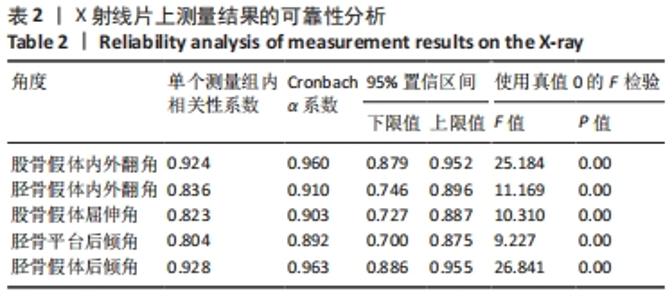
2.4 X射线片上角度测量的可靠性分析 由2名医师独立使用影像归档和通信系统进行测量,测量角度包括术前胫骨平台后倾角,术后股骨假体内外翻角、胫骨假体内外翻角、股骨假体屈伸角、胫骨假体后倾角,每个角度得出2个测量结果;对此采用双向随机效应模型可靠性分析,组内相关系数取95%的可信区间。此次研究以2名医师测量结果均值为分组依据,故采用平均度量组内相关性系数即Cronbach α评价一致性。一般认为,Cronbach α ≥ 0.80为强,0.60-0.79为中等,0.30-0.59为可,< 0.30为弱。此次研究中,通过SPSS软件得出每个测量指标的Cronbach α均大于0.80,说明这2名医师的测量结果具有良好的一致性,详见表2。"
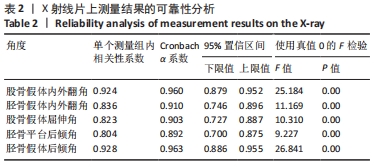
| [1] REN Y, HU J, TAN J, et al. Incidence and risk factors of symptomatic knee osteoarthritis among the Chinese population: analysis from a nationwide longitudinal study. BMC Public Health. 2020;20(1):1491. [2] HU D, HUANG Z, ZHANG W, et al. Analysis of medial unicompartmental knee arthroplasty for patients with spontaneous osteonecrosis of the knee. Zhongguo Xiu Fu Chong Jian Wai Ke Za Zhi. 2019;33(1):13-17. [3] JENSEN CB, PETERSEN PB, JØRGENSEN CC, et al. Length of Stay and 90-Day Readmission/Complication Rates in Unicompartmental Versus Total Knee Arthroplasty: A Propensity-Score-Matched Study of 10,494 Procedures Performed in a Fast-Track Setup. J Bone Joint Surg Am. 2021;103(12):1063-1071. [4] KOZINN SC, SCOTT R. Unicondylar knee arthroplasty. J Bone Joint Surg Am. 1989;71(1):145-150. [5] MC KEEVER DC. The choice of prosthetic materials and evaluation of results. Clin Orthop. 1955;6:17-21. [6] HALAWI MJ, BARSOUM WK. Unicondylar knee arthroplasty: Key concepts. J Clin Orthop Trauma. 2017;8(1):11-13. [7] GOODFELLOW J, O’CONNOR J. The mechanics of the knee and prosthesis design. J Bone Joint Surg Br. 1978;60-b(3):358-369. [8] FRANZ A, BOESE CK, MATTHIES A, et al. Mid-Term Clinical Outcome and Reconstruction of Posterior Tibial Slope after UKA. J Knee Surg. 2019;32(5):468-474. [9] BRUNI D, GAGLIARDI M, AKKAWI I, et al. Good survivorship of all-polyethylene tibial component UKA at long-term follow-up. Knee Surg Sports Traumatol Arthrosc. 2016;24(1):182-187. [10] PLANCHER KD, SHANMUGAM JP, BRITE JE, et al. Relevance of the Tibial Slope on Functional Outcomes in ACL-Deficient and ACL Intact Fixed-Bearing Me dial Unicompartmental Knee Arthroplasty. J Arthroplasty. 2021;36(9):3123-3130. [11] VAN DER LIST JP, KLEEBLAD LJ, ZUIDERBAAN HA, et al. Mid-Term Outcomes of Metal-Backed Unicompartmental Knee Arthroplasty Show Superiority to All-Polyethylene Unicompartmental and Total Knee Arthroplasty. HSS J. 2017;13(3):232-240. [12] WIIK AV, NATHWANI D, AKHTAR A, et al. The unicompartmental knee is the preferred side in individuals with both a unicompartmental and total knee arthroplasty. Knee Surg Sports Traumatol Arthrosc. 2020; 28(10):3193-3199. [13] WEINBERG DS, GEBHART JJ, WERA GD. An Anatomic Investigation Into the Relationship Between Posterior Condylar Offset and Posterior Tibial Slope of One Thousand One Hundred Thirty-Eight Cadaveric Knees. J Arthroplasty. 2017;32(5):1659-1664.e1651. [14] 郭万首. 单髁关节置换手术技术[J]. 中华关节外科杂志(电子版), 2015,9(3):380-382. [15] HERNIGOU P, DESCHAMPS G. Posterior slope of the tibial implant and the outcome of unicompartmental knee arthroplasty. J Bone Joint Surg Am. 2004;86(3):506-511. [16] 马路遥, 郭万首, 张启栋. 胫骨假体后倾对Oxford单髁关节置换术后短期临床结果的影响[J]. 中华外科杂志,2017,55(6):430-434. [17] 马广文, 黄斐, 吴云峰, 等. 胫骨后倾截骨对活动平台单髁关节置换术疗效的影响[J]. 中华骨与关节外科杂志,2017,10(4):302-304, 320. [18] KANG KT, PARK JH, KOH YG, et al. Biomechanical effects of posterior tibial slope on unicompartmental knee arthroplasty using finite el ement analysis. Biomed Mater Eng. 2019;30(2):133-144. [19] KOH YG, PARK KM, KANG K, et al. Finite element analysis of the influence of the posterior tibial slope on mobile-bearing unicompartmental knee arthroplasty. Knee. 2021;29:116-125. [20] LI Z, CHEN Z, WEI J, et al. Excellent outcomes with Oxford Uni-compartmental knee arthroplasty in anteromedial osteoarthritis patients (≤60 years) at mid-term follow-up. BMC Musculoskelet Disord. 2021;22(1):859. [21] GOODFELLOW JW, O’CONNOR J. Clinical results of the Oxford knee. Surface arthroplasty of the tibiofemoral joint with a meniscal bearing prosthesis. Clin Orthop Relat Res. 1986;(205):21-42. [22] BISWAS D, VAN THIEL GS, WETTERS NG, et al. Medial unicompartmental knee arthroplasty in patients less than 55 years old: minimum of two years of follow-up. J Arthroplasty. 2014;29(1):101-105. [23] SUTER L, ROTH A, ANGST M, et al. Is ACL deficiency always a contraindication for medial UKA? Kinematic and kinetic analysis of implant ed and contralateral knees. Gait Posture. 2019;68:244-251. [24] SONG EK, PARK JK, PARK CH, et al. No difference in anterior knee pain after medial unicompartmental knee arthroplasty in patients with or without patellofemoral osteoarthritis. Knee Surg Sports Traumatol Arthrosc. 2016;24(1):208-213. [25] HURST JM, BEREND KR. Mobile-bearing unicondylar knee arthroplasty: the Oxford experience. Orthop Clin North Am. 2015;46(1):113-124. [26] NUNLEY RM, NAM D, JOHNSON SR, et al. Extreme variability in posterior slope of the proximal tibia: measurements on 2395 CT scans of patients undergoing UKA? J Arthroplasty. 2014;29(8):1677-1680. [27] FUJITO T, TOMITA T, YAMAZAKI T, et al. Influence of Posterior Tibial Slope on Kinematics After Cruciate-Retaining Total Knee Arthroplasty. J Arthroplasty. 2018;33(12):3778-3782.e3771. [28] KANG KT, KWON SK, SON J, et al. The increase in posterior tibial slope provides a positive biomechanical effect in posterior-stabilized total knee arthroplasty. Knee Surg Sports Traumatol Arthrosc. 2018;26(10): 3188-3195. [29] SUZUKI T, RYU K, KOJIMA K, et al. The Effect of Posterior Tibial Slope on Joint Gap and Range of Knee Motion in Mobile-Bearing Unicompa rtmental Knee Arthroplasty. J Arthroplasty. 2019;34(12):2909-2913. [30] ALI AM, NEWMAN SDS, HOOPER PA, et al. The effect of implant position on bone strain following lateral unicompartmental knee arthroplasty: A Biomechanical Model Using Digital Image Correlation. Bone Joint Res. 2017;6(8):522-529. [31] TAKAYAMA K, MATSUMOTO T, MURATSU H, et al. The influence of posterior tibial slope changes on joint gap and range of motion in unicompartmental knee arthroplasty. Knee. 2016;23(3):517-522. [32] INUI H, TAKETOMI S, YAMAGAMI R, et al. Necessary Factors to Achieve Deep Flexion for Asian Populations after Oxford Unicompartmental Knee Ar throplasty. J Knee Surg. 2020;33(3):294-300. [33] ZUIDERBAAN HA, VAN DER LIST JP, KHAMAISY S, et al. Unicompartmental knee arthroplasty versus total knee arthroplasty: Which type of artificial joint do patients forget? Knee Surg Sports Traumatol Arthrosc. 2017;25(3):681-686. [34] DAI YK, LIN W, YANG GM, et al. Joint Awareness after Unicompartmental Knee Arthroplasty Evaluated with the Forgotten Joint Score. Orthop Surg. 2020;12(1):218-223. [35] SUDA Y, TAKAYAMA K, ISHIDA K, et al. Improved implant alignment accuracy with an accelerometer-based portable navigation system in medial unicompartmental knee arthroplasty. Knee Surg Sports Traumatol Arthrosc. 2020;28(9):2917-2923. [36] KAYANI B, KONAN S, PIETRZAK JRT, et al. The learning curve associated with robotic-arm assisted unicompartmental knee arthroplasty: a prospec tive cohort study. Bone Joint J. 2018;100-b(8):1033-1042. |
| [1] | Li Xiaomin, Tian Xiangdong, Tan Yetong, Zhu Guangyu, Wang Rongtian, Wang Jian, Xue Zhipeng, Ma Sheng, Hu Yuanyi, Huang Ye, Ding Tiansong. Changes of lower limb force line and knee function after high tibial osteotomy in osteoporotic medial ventricular knee osteoarthritis [J]. Chinese Journal of Tissue Engineering Research, 2023, 27(9): 1325-1329. |
| [2] | Huang Linke, Wei Linhua, Jiang Jie, Liu Qian, Chen Weiwei. Effects of estrogen combined with treadmill exercise on bone mass and articular cartilage in ovariectomized mice [J]. Chinese Journal of Tissue Engineering Research, 2023, 27(8): 1166-1171. |
| [3] | Li Long, Li Guangdi, Shi Hao, Deng Keqi. Circular RNA as a competing endogenous RNA is involved in the regulation of osteoarthritis [J]. Chinese Journal of Tissue Engineering Research, 2023, 27(5): 751-757. |
| [4] | Yuan Changshen, Guan Yanbing, Li Zhe, Rong Weiming, Liao Shuning, Chen Lewei, Mei Qijie, Duan Kan. Screening and verification of key genes of necroptosis in osteoarthritis [J]. Chinese Journal of Tissue Engineering Research, 2023, 27(5): 695-700. |
| [5] | Liu Guangluan, Guo Zonglei, Ge Jin, Huang Dong, Wang Yehua. Anatomic risk factors for medial meniscus posterior root tears combined with anterior cruciate ligament injuries [J]. Chinese Journal of Tissue Engineering Research, 2023, 27(5): 663-668. |
| [6] | Wan Guoli, Shi Chenhui, Wang Weishan, Li Ang, Shi Xunda, Cai Yi. Retrospective analysis of the influencing factors of chronic pain after total knee arthroplasty [J]. Chinese Journal of Tissue Engineering Research, 2023, 27(4): 558-564. |
| [7] | Gu Mingxi, Wang Bo, Tian Fengde, An Ning, Hao Ruihu, Wang Changcheng, Guo Lin. Comparison of early efficacy and safety of simultaneous and staged bilateral total knee arthroplasty [J]. Chinese Journal of Tissue Engineering Research, 2023, 27(4): 565-571. |
| [8] | Yu He, Zheng Jiafa, Song Xiufeng, Guan Shengyi. Tibiotalocalcaneal arthrodesis with blood supplied fibular flap combined with hollow screw in the treatment of end-stage ankle osteoarthritis [J]. Chinese Journal of Tissue Engineering Research, 2023, 27(4): 588-593. |
| [9] | Guo Yingqi, Gong Xianxu, Zhang Yan, Xiao Han, Wang Ye, Gu Wenguang. Meniscus extrusion and patellofemoral joint cartilage injury and bone marrow lesions: MRI semi-quantitative score [J]. Chinese Journal of Tissue Engineering Research, 2023, 27(4): 600-605. |
| [10] | Yu Jiaan, Liu Xinwei, Lian Hongyu, Liu Kexin, Li Zitao. Medial open-wedge tibial osteotomy versus lateral closed-wedge tibial osteotomy for unicompartmental knee osteoarthritis: a meta-analysis [J]. Chinese Journal of Tissue Engineering Research, 2023, 27(4): 632-639. |
| [11] | Xie Pingjin, Luo Zhen, Lu Qigui, Guo Yanxing, Chen Qunqun, Li Feilong. Effect of ligustrazine and overexpression of miR-20b-5p on synovial, cartilage and subchondral bone angiogenesis in rats with early-stage knee osteoarthritis: a histological observation [J]. Chinese Journal of Tissue Engineering Research, 2023, 27(2): 237-245. |
| [12] | Wang Huanhuan, Wang Qing, Tang Peng, Zhang Rui, Min Hongwei. Effects of extracorporeal shock wave on the proliferation and autophagy of chondrocytes from osteoarthritis rats [J]. Chinese Journal of Tissue Engineering Research, 2023, 27(2): 252-257. |
| [13] | Li Mingxiu, Wang Xuan, Yang Jie, Li Yi. An osteoarthritis model in vitro: characteristics and new design idea [J]. Chinese Journal of Tissue Engineering Research, 2023, 27(2): 300-306. |
| [14] | Liu Yinghong, Yi Yating. Mechanism and implication of angiogenesis in osteoarthritis [J]. Chinese Journal of Tissue Engineering Research, 2023, 27(2): 307-313. |
| [15] | Li Shichao, Xie Guangyue, Sun Zhen, Han Peng, Hou Xiaohua, Sun Xiaowei, Zhang Qidong. Correlation of knee joint alignment correction between valgus stress and postoperative radiography after unicompartmental knee arthroplasty [J]. Chinese Journal of Tissue Engineering Research, 2023, 27(18): 2910-2914. |
| Viewed | ||||||
|
Full text |
|
|||||
|
Abstract |
|
|||||
